Fun Facts About Solar Systems
Written by Aindrila Jana, writer
Why do we call it the Solar System?

Written by Aindrila Jana, writer
| WHY DO WE CALL IT THE SOLAR SYSTEM |
| The name of our sun – which is a star – comes from a latin word for sun, which is “solis” |
| From Solis comes the word “solar”, which we use to describe things related to our sun – that’s why it’s called solar system |
| Other planetary systems are not called by this name! |
Before we understand all there is to know about our solar system, let’s know this.
There are billions of stars or planetary systems in the universe, which are located inside billions of galaxies.
Our solar system is just one of them, in one tiny part of one galaxy called the Milky Way!
What’s our solar system?
Our solar system consists of the Sun and all that is bound to it by gravity (a force) – meaning the planets, dwarf planets, moons, millions of asteroids, comets, and meteoroids.
Our planets are mainly classified into inner and outer planets based on a few factors. Here’s a quick view…
| Inner Planets | Outer Planets |
| Mercury, Venus, Earth, and Mars – closest to the sun. Are smaller in size | Jupiter, Saturn, Uranus, and Neptune – further away from the sun. Are much bigger in size |
| Made of rocks and metals, have solid surfaces and thin or no atmosphere. You can stand there. Are often called “terrestrial planets” . | Mostly made of gases like hydrogen, helium and ammonia. Some astronomers believe that some (or all) of them may have solid cores. You can’t stand there |
| Spin slowly | Spin fast |
| Have fewer moons – Earth has one moon and Mars has two small moons only | Have many moons – Jupiter has 63 . Saturn has 60, Uranus has 27 and Neptune has 13 moons |
What about Pluto?
Pluto was once a planet but it’s not anymore. It was downgraded to a dwarf planet in 2006.
How far does the solar system extend?
The solar system extends from the sun to the inner planets, then goes through, what’s called the Asteroid Belt, onto the outer planets (the four gas planets). It then carries on to another belt, known as the Kuiper Belt to the outer border of the solar system called the heliopause.
The edge of the solar system is estimated to be about 9 billion miles (roughly about 15 billion kilometers) from the sun.
What lies beyond?
A lot.
But immediately beyond the outer edge lies the Oort Cloud, which surrounds the solar system. This part is said to be filled with icy objects.
Planets and their orbits
All the planets orbit the Sun as their focus as the Sun is the biggest star in our Solar System. And here’s something important to know – the orbits (the curved path) of the planets are elliptical – meaning they go around the sun not in circles, but in sort-of elongated circles, or oval paths.
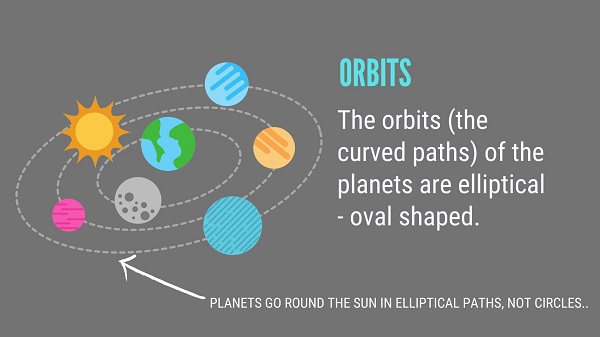
Let’s look at the two main belts (regions) in our solar system – the asteroid belt and the Kuiper Belt.
The Asteroid Belt
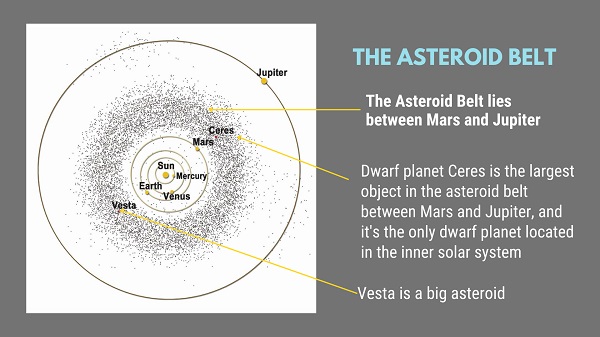
This is the region of space between the orbits of Mars and Jupiter that contains millions of asteroids.
Why are there so many asteroids here?
The popular opinion is that this belt is made up of material that either never formed into planets or that they are actually leftover parts of planets that broke up.
The Kuiper Belt
The Kuiper Belt is a massive part of space that lies beyond planet Neptune. It’s so that this is actually one of the largest parts of our solar system.
Here’s where it is…

This belt is full of icy objects, which astronomers believe, are remains of the formation of the solar system.
More Details about the planets in our Solar System
The order of the planets in the solar system, starting from the nearest to the Sun to the farthest is the following: Mercury, Venus, Earth, Mars, Jupiter, Saturn, Uranus, and Neptune.
Mercury
Mercury is the closest planet to the sun and it is the smallest planet in the solar system. It revolves around the sun in only 88 days. Mercury is just 36 million miles (58 million kilometers) away from the Sun.
Mercury experiences dramatic changes in its day and night temperatures. The temperature of Mercury can reach a scorching 840 F (450 C) in the daytime and during the night, temperatures drop down to minus 290 F (minus 180 C). Mercury has no moons. There are also no rings around Mercury
The atmosphere of Mercury is very thin and is primarily composed of oxygen, sodium, hydrogen, helium, and potassium. Because the atmosphere is so thin it cannot resist incoming meteors, hence its surface is marked with craters.
Two NASA missions have explored Mercury: Mariner 10 was the first to fly by and MESSENGER was the first to orbit the planet. ESA’s BepiColombo is on its way to Mercury.
Venus
Venus is the second planet from the sun and it is also the hottest planet in the solar system. It has a toxic atmosphere composed of sulfuric acid clouds.
Venus is the second closest planet to the Sun.
The average temperature on Venus’ surface is 900 F (465 C). The surface pressure is extremely high. Venus spins slowly from east to west, following the direction opposite to most of the other planets. One day on Venus consists of 243 Earth days. It orbits the Sun faster than Earth however and one year on Venus takes only about 225 Earth days, making a Venusian day longer than its year!
Venus is sometimes called Earth’s twin as they are similar in size. Radar images beneath its atmosphere have shown the existence of many mountains and volcanoes.
Earth
Earth, our home planet, is the third planet from the sun. It is located at a distance of about 93 million miles (150 million km). Two-thirds of the planet is covered with water. Its atmosphere is rich in nitrogen and oxygen and it is the only planet known to harbour life.
Earth rotates on its axis at 467 meters per second at the equator. It revolves around the sun at a speed of more than 18 miles per second (29 km per second).
A day on Earth is 24 hours. Earth makes a complete orbit around the sun (one year on Earth) in about 365 days.
Earth’s atmosphere has 78 percent nitrogen, 21 percent oxygen, and one percent other ingredients, creating the perfect balance to breathe and live. Our Earth has one moon and no rings.
Mars
Mars is the fourth planet from the sun. It is a cold, desert-like planet covered in iron oxide dust that gives the planet its red colour. Mars shares some similarities with Earth: It is rocky, and has mountains, valleys, and canyons and storm systems ranging from localized tornadoes of dust to planet-engulfing dust storms.
Sheets of water lie beneath the surface of Mars and at both poles are ice caps which in parts are made of frozen water.
Mars orbits the Sun once in 687 Earth days and a year on Mars is nearly twice as long as a year on Earth. It spins on its axis once every 24 hours 37 minutes, making a day on Mars a little longer than an Earth day. Having an elliptical orbit, southern summers are shorter (154 Martian days) and warmer than those in the north (178 Martian days). The planet Mars has two moons, Phobos and Deimos, and no rings.
The possibility of current lifeforms existing on the Red Planet has made us conduct numerous Mars missions from Earth and hence, the Red Planet is now one of the most explored planets in the solar system.
Jupiter
Jupiter is the fifth planet from the sun and is the largest planet in the solar system – so big that it is twice as big as all the other planets combined.
Its swirling clouds are colourful due to the presence of different trace gases including ammonia ice, and ammonium hydrosulfide crystals including water, ice and vapour.
A famous feature is Jupiter’s Great Red Spot, a giant storm more than 10,000 miles wide. It was first observed in 1831 by astronomer Samuel Heinrich Schwabe. It has raged at the speed of more than 400 mph for the last 150 years, at least.
Jupiter has a strong magnetic field. It has 75 moons, including the largest moon in the solar system, Ganymede.
Saturn
Saturn is the sixth planet from the sun and it is famous for its large and distinct ring system. Saturn has seven rings and several gaps and divisions between them.
The planet takes about 10.7 hours to rotate once on its axis which comprises a Saturn “day” and 29 Earth years to orbit the sun.
Saturn’s atmosphere is made up mostly of hydrogen (H2) and helium (He) gases. It has 53 known moons and an additional 29 moons awaiting confirmation of their discovery, which makes a total of 82 moons.
Uranus
Uranus is the seventh planet from the Sun and is the planet with the third largest diameter in our solar system. Being very cold and windy, Uranus is surrounded by 13 faint rings, and 27 known moons and it rotates at a nearly 90-degree angle from the plane of its orbit. The inner rings are mostly narrow, dark, and grey. There are two outer rings: the inner ring is reddish and dusty and the outer ring is blue.
Uranus was discovered in 1781 by astronomer William Herschel who originally thought it was either a comet or a star. Two years later, the object was universally accepted as a new planet because of observations by astronomer Johann Elert Bode.
It has a radius of 15,759.2 miles (25,362 kilometers) and is 4 times wider than Earth. Uranus takes about 17 hours to complete one rotation and about 84 Earth years to make a complete orbit around the Sun.
Uranus doesn’t have a true surface. The planet is composed mostly of swirling fluids and is an ice giant.
Neptune
Neptune is the eighth and most distant planet in our solar system. Johann Galle discovered the planet in 1846 using predictions made by Urbain Le Verrier.
It has a radius of 15,299.4 miles (24,622 kilometers) and is about four times wider than Earth. It takes about 16 hours to rotate once. It makes a complete orbit around the Sun in about 165 Earth years.
Neptune has about 14 known moons. Its largest moon Triton was discovered by William Lassell on October 10, 1846. It has at least five main rings and four prominent ring arcs. The main rings are named Galle, Leverrier, Lassell, Arago and Adams.
Top 20 Fun Facts About the Solar System
1. The second smallest planet in the Solar System, Mars has an average temperature of roughly minus 60°C (which is about minus 80 degrees Fahrenheit).
2. Saturn’s largest moon Titan is bigger than the planet Mercury. Also, it’s the only moon in the solar system that has its own atmosphere.
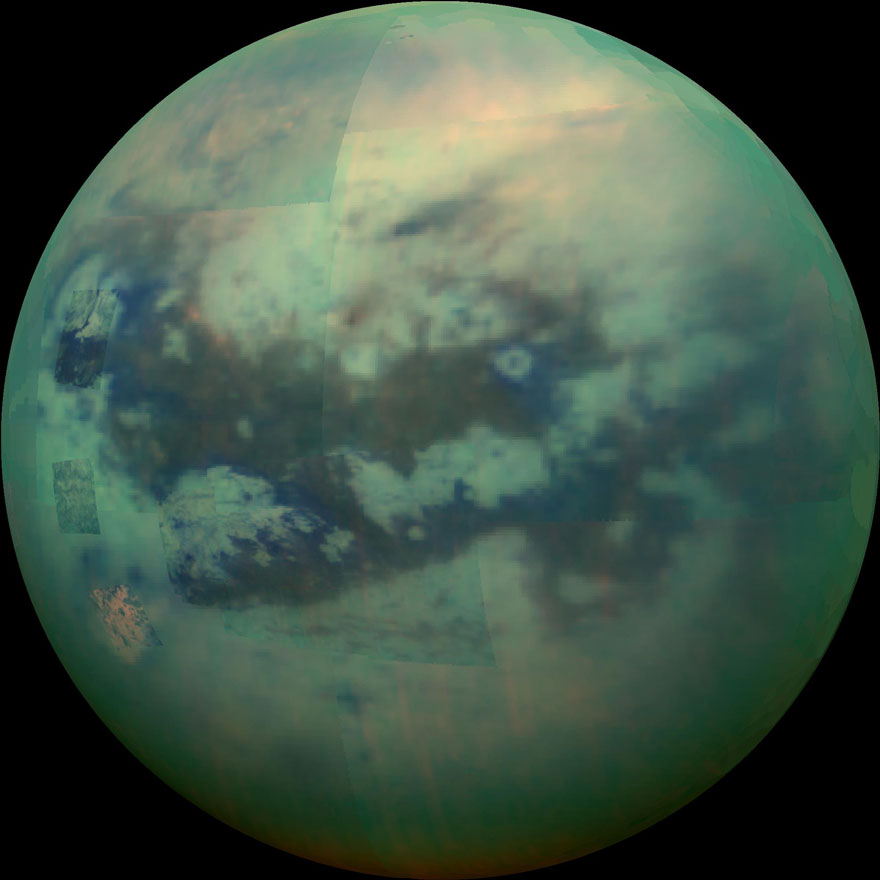
3. Mercury, being the closest planet to the Sun, takes around three Earth months to orbit the Sun. It has the smallest orbit in the Solar System.
4. A day on Venus is longer than a year on it! Incredible as that sounds, it is true. This is because Venus takes longer to rotate once on its axis than to orbit of the Sun once! It takes 243 Earth days to rotate once – the longest rotation of any planet in the Solar System.
5. Currently, there are five dwarf planets that have been officially recognized in our Solar System by the International Astronomical Union – though many believe that there are more (like 50). However, these five include Pluto, Ceres, Makemake, Haumea, and Eris. In 2018, a new dwarf planet was discovered. It was named 2015 TG387 and nicknamed ‘The Goblin’.
6. The largest moon of Jupiter, Ganymede, has a salty ocean and is said to hold more water than water available on Earth.
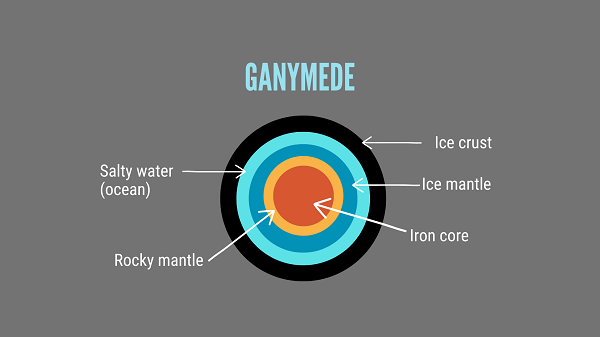
7. Olympus Mons is the biggest volcano discovered in the Solar System. This gigantic volcano is found on Mars and is comparable to the size of Arizona. Its height is 3 times the height of Mount Everest, which is the tallest mountain on Earth. Also, it is 100 times larger than Earth’s largest volcano, Hawaii’s Mauna Loa, according to the data released by NASA.
8. The upper winds of Venus flow 50 times faster than the speed of its rotation. Hence, Venus is characterized by super-powerful winds. This dry and windy atmosphere on Venus negates the possibility of life.
9. The Oort Cloud, which is the furthest part of our solar system is said to be the place where most comets come from! There are said to be billions of comets in the solar system. Scientists, however, have so far confirmed 3,535.
10. Pluto was named by an 11-year-old girl on March the 14th, 1930.
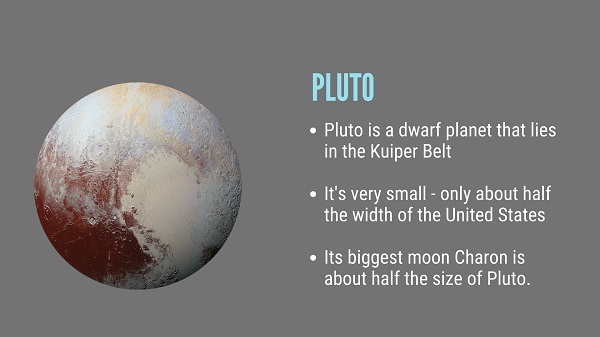
Pluto is a dwarf planet located in, what’s called the Kuiper Belt. Icy mountains which are 11,000 feet high were found by NASA’s New Horizons spacecraft which flew by Pluto in 2015.
11. Uranus, the seventh planet from the Sun, has an unusual spinning orientation. Compared to the other planets, it rotates about 90 degrees sideways. This causes extreme seasons on the planet. The Sun shines directly over the north pole or the south pole of the planet for about a quarter of each Uranus year. That means for more than twenty years on Earth, half of Uranus never gets to see the Sun at all.
12. Io, Jupiter’s moon, is considered to be the most active moon when it comes to volcanoes in the Solar System.
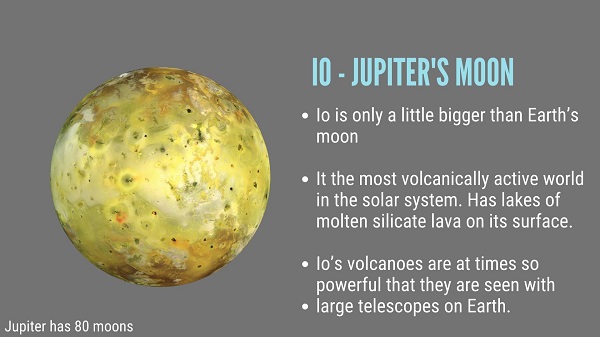
Io has hundreds of volcanoes and many of these have lava erupting that goes up for miles in the air! It is also said to be the fourth-largest moon in the solar system.
13. Venus, also known as the evening or the morning star, can be seen from Earth. Yellow clouds composed of sulfur cover the entire planet and this causes the light from the sun to reflect off the surface of Venus. Hence we can often see it at night. This also makes the planet Venus the second brightest object in the night sky after the Moon.
14. The Great Red Spot on Jupiter is an area where a giant hurricane-like storm has been raging continuously for over 300 years. The storm has fierce winds of around 270 miles per hour. Also, the size of the Great Red Spot is over two times the size of Earth.
15. The speed of winds on Neptune is the fastest! Winds blow at the rate of about 1,600 miles per hour.
16. ‘Space junk’ is defined as man-made objects floating around in space. It is estimated that there are at least 500,000 pieces of space junk currently in orbit. They include fragments of satellites and rockets and even tools dropped during the construction of the International Space Station.
17. Every single footprint left on the Moon will not disappear for approximately 100 million years. This is because there’s no wind or water on the Moon that will erode and wash away the footprints on the surface.
18. Saturn is so big that more than 700 Earths could fit inside it! Also, its rings are said to be thousands of miles wide. If you were to drive a car across some of Saturn’s rings, it would take a week to do so!
19. Uranus gets its blue-green color from methane gas in the atmosphere.
20. The largest mountain in the solar system is found on Mars. It is 78,000 feet above the surface – which is roughly 24 kilometers!.
Who discovered the solar system?
Let’s go back in a time a bit to understand this – there have been a few diferent theories put forth by astronomers and mathemiticans over a period of time.
For hundreds of years it was believed that the Earth was the center of the universe and that the sun went around it. This theory was challenged later.
Here’s more about how we discovered what our solar system really is…
Let’s begin with Aristotle (384 BC – 322 BC), who believed in, what’s called, geocentric model (Earth-centric) of the solar system – which is that the the sun, moon, stars, and planets all orbit the Earth.
Aristotle’s theory was supported by Ptolemy (full name – Claudius Ptolemaeus) – an Egyptian astronomer and mathematician who lived in the 2nd century CE. He too believed in the geocentric thoery that the Earth was the centre of the univerise. This view was accepted and seen as the truth for about 1400 years and it was known as the Ptolemaic system .

Then came a few astronomers and mathematicians who challenged this theory.
These were Copernicus, Galileo, and Newton – who lived in, what’s called the ,”Renaissance” period – a time loosely defined as being between the 14th and the 17th century. Their observations and calculations proved that the sun and not the Earth was the at the center of the solar system – a theory that took several hundred years to be accepted.
We mention a few key names here, who were largely responsible for unveling what we know about the solar system today
Nicolaus Copernicus
He was a famous Polish astronomer who proposed the main idea that the sun was at the center of the universe and that the planets moved around it in perfect circles.
Copernicus, however, was not the first person to come up with this theory, eevn if he was the one who made it popular. He was, in fact, inspired by a Greek astronomer astronomer named Aristarchus of Samos (who lived in , (c. 310 BCE—c. 230 BCE), who believed that the Earth rotated on its axis and revolved around the Sun.
And, here’s the interesting part.
In the manuscript (book before its published) of his book, ‘Six Books Concerning the Revolutions of the Heavenly Orbs’ Copernicus makes references to Aristarchus and his theory. But, this reference is later deleted and was not finally mentioned in the published book.
The trouble with the new, popular sun-centric theory…
This theory was not easily accpetd by the people at the time. One, because it challneged a long-established theory of the Earth being at the center and two because physically, people thought they saw the sun move across the sky, so they believed that it was the sun that moved and not the earth.
Other supporters…
The Copernican concept that the Sun was at the center of the universe was supported by the German astronomer Johannes Kepler. However, he had analternate view of the orbits of the planets – he proposed that the planets had elliptical orbits, with the Sun in one of the foci of each ellipse, thus describing their complicated motions more accurately.
Galileo Galilei
Then came one of the most famous astronomers of them all – Galileo Galilei, an Italian astronomer and physicist. He is best known for his pathbreaking calculations using the telescope for observing the night sky. His discoveries about our solar system challenged long-standing and geo-centric theories.
Galileo, it is to be noted, did not invent the telescope. However, the reason why his name is mentioned with telescopes is because he built higher-quality telescopes that had improved magnifying power (eight or nine times more than the regular telescopes at the time) to make observations in the night sky. He would grind and polish his own lenses and his superior telescope made it possible for him to see, for instance, that the Moon had mountains and that Jupiter had satellites.
Using his powerful telescops Galileo made many discoveries – one of which was that Sun was the centre of the Solar System and not the Earth. His observations supported, was is called, the Heliocentric model – which puts the sun at the centre of the universe and not the Earth (which, as mentioned above is called the geo centric model).
Did you know that Galileo’s theory was not accepted by the Roman Catholic Church at the time. For these seemingly bizarre suggestions Galileo was sentenced to life imprisonment 1633.
He was put under house arrest and died at home in 1642 after an illness.
Isaac Newton
English physicist, mathematician, and astronomer Isaac Newton is best known best for disocvering the laws of gravity, but Newton also brought the laws of physics to the solar system.
He explained the motion of planets, shedding light on the way they move. Newton was the one who invented the theory of gravitational force to calculate motion of planets. Moreover, Newton built the first reflecting telescope to make observation in the night sky.
Newton’s laws became the basis for further exploration of “celestial mechanics”. Pierre Simon Laplace, Urbain Leverrier, and Joseph Louis Lagrange were the major contributors to the field of celestial mechanics.
Some key discoveries in the solar system
Neptune was discovered by the German astronomer Johann Galle in 1846.
English astronomer Edmond Halley discovered that comets were a part of the Solar System.
The Kuiper Belt gets its name from the Dutch-American astronomer Gerard Kuiper who is seen as the father of modern planetary science. He was the one who discovered the region of icy objects that lies outside the orbit of Neptune. This is the place where many comets originate.
Some of Kupier’s other discoveries include:
- Carbon dioxide is a large part of the atmosphere of Mars.
- The rings of Saturn are made of particles of ice.
- Doscovery of Miranda, Uranus’s fifth moon.
The “Oort Cloud” was named after the Dutch astronomer Jan Hendrik Oort.
The formation of the solar system
Our solar system formed about 4.5 billion years ago.
How our Sun formed
Here’s a super-condensed and simplified version….
Five billion years ago, a giant cloud made of gas and dust – mostly hydrogen and helium – was floating in the Milky Way. Also part of this massive cloud were some atoms that were formed much earlier when other stars died.
Then this cloud, called a nebula started to collapse – some astronomers say this could have happened because of the shockwaves created by a exploding star somewhere near by – called a supernova.
When this happened, the atoms began to collide with each othe generating a lot of heat and energy. This process finally led to the creation of a massive amount of energy that led to the birth of a star, which we know as the sun.
How were planets born?
After the formation of our sun, there was a lot of leftover material in this disk of the new star. But, the temperature in this region, called the proplanetary disk, was not the same.
Our planets were mainly formed by the fusion (coming together) of this material.
But, here’s the thing – the region was made of a lot of different kinds of material and gasses, all of which condensed at different temperatures. This is why different types of planets were formed – the innner planets, as we’ve disussed in the beginning were made of rocks and the outer ones of gasses.
The inner planets
The heavier minerals going around etc fused to become solid rocks. Over time, these pieces of minerals and rocks became bigger through a process called accretion – which basically means a process where gravity pulls and joins things together. In this case when the rocks became big enough, . gravity forced them to turn into spherical shapes. This is what happened with the inner planets, that existed before, what’s called, the frost line – basically the line from the sun after which is gets colder.
The outer planets
The giant planets, which are Jupiter, Saturn, Uranus, and Neptune, formed beyond the Frost Line – where the material was cool enough for volatile icy compounds to remain solidified. The ice and frosty materials that formed these planets were much more plentiful than metals and silicates that formed the terrestrial inner planets, hence they grew massive in size.
The leftover debris that never became planets got congregated in certain regions like the Asteroid Belt, Kuiper Belt, and Oort Cloud.
This was about our solar system in a nutshell.
Here’s a great video for you to watch to know how the soalr system formed:

Better Your Child’s G.K. In 3 Minutes – Get This Free Newsletter
Get fun facts, simple and easy news, quizzes, and lots of other interesting things to read in your mailbox – for free! It’s what we call GK-on-the-go!
I Kid You Not now has a large readership across India and also parts of the world. If you want to write for us, you can submit your story here. You can also apply to become a news anchor. Apply here



Comments